Opel Blitz
Opel Blitz (German for "lightning") was the name given to various light and middle-weight truck series built by the German Opel automobile manufacturer between 1930 and 1975. The original logo for this truck, two stripes arranged loosely like a lightning symbol in the form of a horizontally stretched letter "Z", still appears in the current Opel logo.[1]
| Opel Blitz | |
|---|---|
 Blitz 1.5 T | |
| Overview | |
| Manufacturer | Opel |
| Production | 1930–1975 |
| Assembly | Rüsselsheim Opelwerk Brandenburg, Mercedes-Benz Mannheim Blitz 3.6 until 1944 |
| Body and chassis | |
| Class | light/medium truck/ light commercial vehicle |
| Body style | Van Pickup truck Minibus |
| Chronology | |
| Successor | Bedford Blitz (van/minibus) Bedford KB (pickup) |
History
1930
During the years preceding World War II Opel was Germany's largest truck producer. The Blitz name, coined in a prize competition, was first applied to an Opel truck in 1930. As part of the Nazi economy and the German re-armament efforts the authorities ordered the construction of the Opelwerk Brandenburg facilities in 1935, and through 1944 more than 130,000 Blitz trucks and chassis were produced.
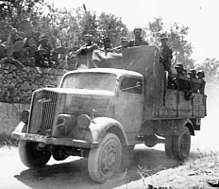
By 1934 there were four versions offered of the 1 tonne basic model along with fourteen versions of the larger 2 and 2½ tonne trucks. The medium-weight versions originally were equipped with a flathead 68 HP petrol engine coming from the 1930 GM Buick Marquette, replaced in 1937 with a modern overhead valve 75 HP straight-six engine also used in Opel Admiral passenger cars. This engine was very similar to Chevrolet engines from the same period, to the point that disabled Blitzes abandoned by fleeing Germans could be easily put back into operation by advancing Allies using Chevy/GMC and Bedford parts.
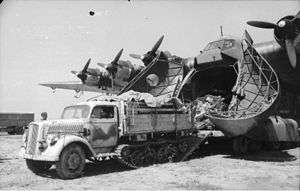
From 1939, the Blitz 3.6 three-ton version was used in large numbers by the German Wehrmacht armed forces throughout World War II. Variants included an elongated version and the four-wheel drive Blitz A. To cope with the bad road conditions and the rasputitsa mud seasons on the Eastern Front, a half-tracked Maultier (mule) Sd.Kfz. 3 version was built using tracks and suspension based on the Universal Carrier. Among others, these were used as service vehicles for the Messerschmitt Me 323 military transport aircraft.
The light basic model was manufactured as Blitz 2.5 in Rüsselsheim until 1942 and again from 1946, equipped with the 55hp Opel Super 6 engine. On 6 August 1944, the Opelwerk Brandenburg was devastated by an RAF air raid. Furthermore, until the end of the war, about 2,500 Blitz 3.6 trucks were built by order of Minister of Armaments Albert Speer at the Mannheim plant of the rival Daimler Benz AG, while the production of its own Mercedes-Benz L3000 model had to be discontinued. After the war, the facilities in Brandenburg were completely dismantled at the behest of the Soviet Military Administration, while Daimler-Benz in Mannheim resumed building the Blitz 3.6 under the designation L 701 until 1949. The last 467 medium trucks were again assembled by Opel in Rüsselsheim until production finally discontinued in 1954 without a successor.
Nazi War Crimes
It is claimed that Opel, a subsidiary of GM, used forced labor to build the Blitz.[2] The degree to which the US branch of GM controlled Opel at the time is subject to debate, but by production numbers alone, it is evident that Opel was heavily involved in production of trucks and other equipment for the Nazi war machine.[3][4]
The Opel Blitz was one of the vehicles (along with Renault[5], Saurer and Magirus based vehicles) used by Germans in The Holocaust as a modified carbon monoxide gas van.[6]
Post-war
After the end of the war, with the Brandenburg plant dismantled and transported to the Soviet Union, and 47% of the buildings in Rüsselsheim destroyed, former Opel employees began to rebuild the Rüsselsheim plant. The first postwar Blitz was completed on 15 July 1946 in the presence of United States Army General Geoffrey Keyes and other local leaders and press reporters.[7]
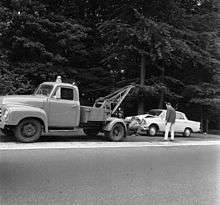
The first post-war designed Blitz in 1952 was a modern rounded design, reminiscent of the contemporary GMC and Chevrolet pickup trucks. The new 1.75 ton truck was offered with a van and pickup body. The new model retained the pre-war chassis with the straight-six petrol engine. Opel remained the market leader for light trucks despite strong competition especially by the newly designed 1955 Mercedes-Benz L 319 model and the Ford FK series, as well as Hanomag and Borgward vans. A coach version was built by the Karl Kässbohrer Fahrzeugwerke from 1953 to 1956. The 1.75 to model was a very popular fire engine (LF8-TS), typically equipped with an engine driven pump mounted at the front bumper and a second, portable pump in the back of the truck. The portable pump was powered by a 34 hp Volkswagen engine and weighed about 400 lbs. Firetruck conversions were made by companies such as Ziegler, Metz and Rosenbauer.
In 1960, the 1.9 to with 2.6 L engine replaced the previous 1.75 to model. This model (later dubbed Opel Blitz A) was distinguished by a cab forward design and a revised six cylinder engine, leading to less overall length and more cargo space. Due to the powerful engine, the truck was an excellent performer for its time, and the 1.9 to with 2.6 L engine was like his predecessor a common base for a light fire truck. The configuration was similar to the one described above for the 1.75 to. However, commercial sales of this model declined during the production run, mainly due to the lack of an economic Diesel option.
The Opel Blitz B was launched in 1965, and was the last of the Opel Blitz trucks. To improve fuel economy, this model was available in 1.9 liter four cylinder CIH option. Alternatively, a 2.5 liter six-cylinder version of the new CIH engine series could be ordered. These engines were also available in the contemporary Rekord and Commodore models, but the Blitz engines had a stronger ground construction and was de-tuned for more torque and better economy.
Under pressure from strong competition of the popular Mercedes-Benz T2 model, in 1968, Opel finally offered a 2,100 cm³ Indenor XDP 4.90 diesel engine (the Peugeot 504 engine) - too late to regain lost market shares. Opel GM decided not to develop a successor, and in 1975, the production of Opel commercial vehicles finally ceased.
Successor
According to the corporate policy of General Motors, from 1973 to 1987 a successor vehicle[8] produced by Bedford Vehicles of Luton, and based on the Bedford CF, was sold in some markets as the Bedford Blitz.[9] Since 1998 Opel again offers a light commercial vehicle with the Movano model based on the Renault Master.
Gallery
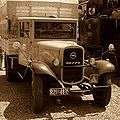 1934 Blitz truck (with contemporary logo)
1934 Blitz truck (with contemporary logo)- World War 2 era Blitz 2.5
 Four-Wheel Drive Blitz A 3.6 with blackout light
Four-Wheel Drive Blitz A 3.6 with blackout light- Daimler-Benz L 701 copy running on wood gas
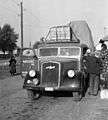 1941 Blitz
1941 Blitz- 1951 Blitz
- 1950s Pickup Truck
 1950s panel van
1950s panel van 1950s Coach Body
1950s Coach Body 1960 Fire Brigade Truck
1960 Fire Brigade Truck 1962 Opel Blitz 1.9 to with 2.6 L engine
1962 Opel Blitz 1.9 to with 2.6 L engine Opel Blitz A Tow Truck (Build: Kaufmann Zweibrücken, Germany)
Opel Blitz A Tow Truck (Build: Kaufmann Zweibrücken, Germany)- 1965 Pickup Truck
- 1965 Deutsche Bundespost Van
 1965 Coach
1965 Coach Opel Blitz Tow Truck Early 80s (Build: Kaufmann Zweibrücken, Germany)
Opel Blitz Tow Truck Early 80s (Build: Kaufmann Zweibrücken, Germany) Opel Blitz Rig Truck
Opel Blitz Rig Truck Opel Blitz Double Cab Tow Truck Early 80s (Build: Kaufmann Zweibrücken, Germany)
Opel Blitz Double Cab Tow Truck Early 80s (Build: Kaufmann Zweibrücken, Germany) Late Model Opel Blitz B Fire Truck
Late Model Opel Blitz B Fire Truck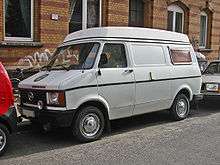 1980 Bedford Blitz
1980 Bedford Blitz
References
- http://www.deathcamps.org/gas_chambers/gas_chambers_vans.html
- "Working for the Enemy". Retrieved 6 October 2014.
- "General Motors and the Nazis". Retrieved 6 October 2014.
- "General Motors & the Third Reich". www.jewishvirtuallibrary.org. Retrieved 2020-04-22.
- "Court rejects Renault challenge". BBC News. 2012-01-11. Retrieved 2020-04-22.
- http://www.deathcamps.org/gas_chambers/gas_chambers_vans.html
- Martin, F.A.E. (December 1946). "Das Alte stürzt...Es aendert sich die Zeit......und neues Leben blüht aus den Ruinen". Das Auto. 1: 2–3.
- Werner Oswald: Lastwagen, Lieferwagen, Transporter 1945–1988. Motorbuch Verlag, 2. ed. 1993, ISBN 3-613-01197-2
- "Bedford Blitz Kastenwagen (catalogue)". Rüsselsheim, Germany: Adam Opel AG. September 1979: 12. 90014 (979/30/1). Retrieved 2010-12-23. Cite journal requires
|journal=(help)
External links
| Wikimedia Commons has media related to Opel Blitz. |
